PUBH304 - Community Advocacy and Social Determinants of Health
VerifiedAdded on 2023/03/17
|9
|2279
|47
Essay
AI Summary
This essay evaluates two public health programs in Australia addressing homelessness, one deemed problematic and the other exemplary, through the lens of community advocacy and social determinants of health. The Innovative Health Services for Homeless Youth (IHSHY) program is criticized for its top-down approach and narrow focus on Aboriginal youth, neglecting broader community involvement and universal actions. In contrast, the Reconnect program is praised for its bottom-up approach, addressing social determinants like education, employment, and family support, and for its collaborative efforts with high-risk groups. The essay suggests improvements for the Reconnect program, including leveraging media campaigns to raise awareness and upgrading the skills of care providers to address the complex needs of diverse homeless youth populations, ultimately advocating for a more inclusive and effective approach to public health entrepreneurship.
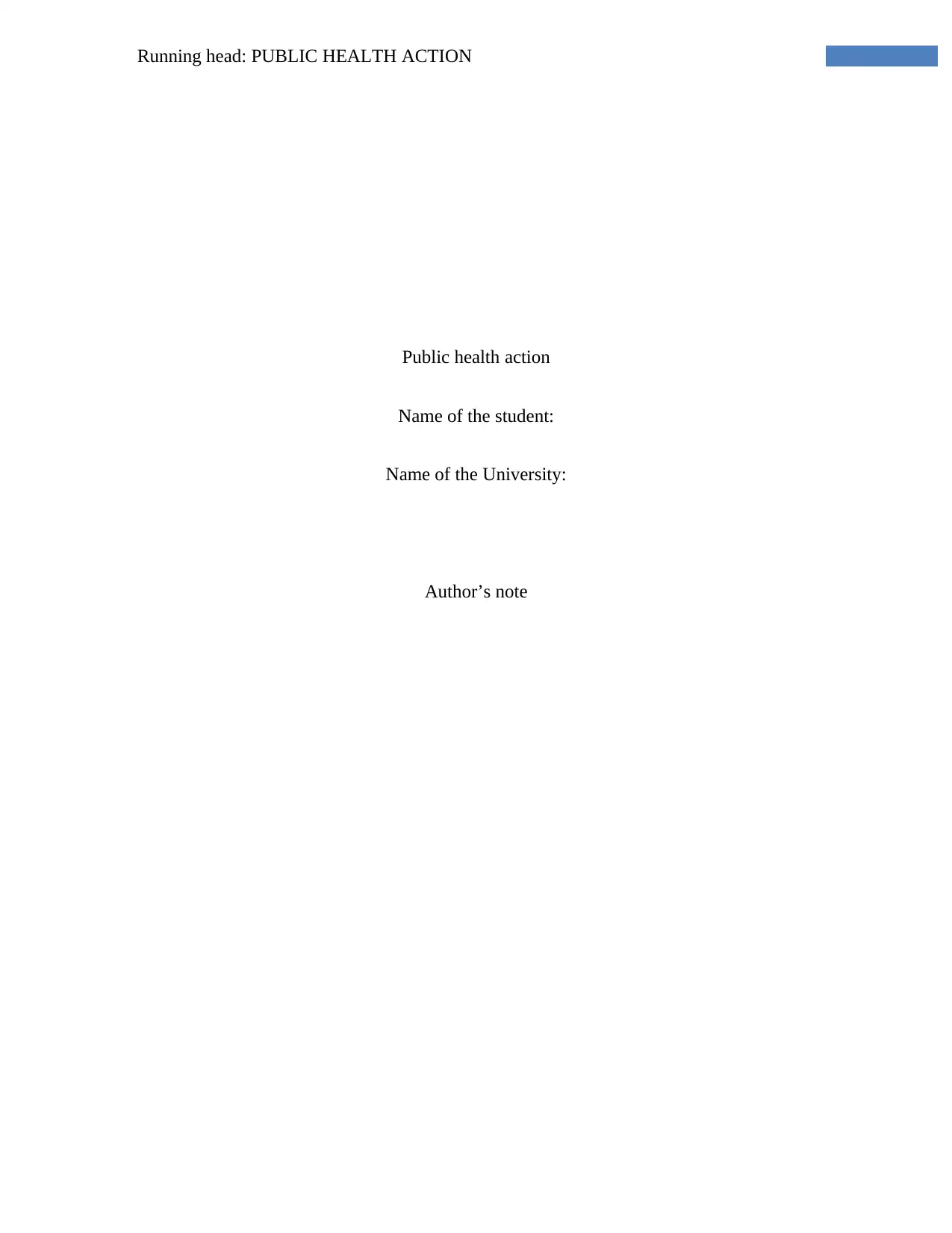
Running head: PUBLIC HEALTH ACTION
Public health action
Name of the student:
Name of the University:
Author’s note
Public health action
Name of the student:
Name of the University:
Author’s note
Paraphrase This Document
Need a fresh take? Get an instant paraphrase of this document with our AI Paraphraser
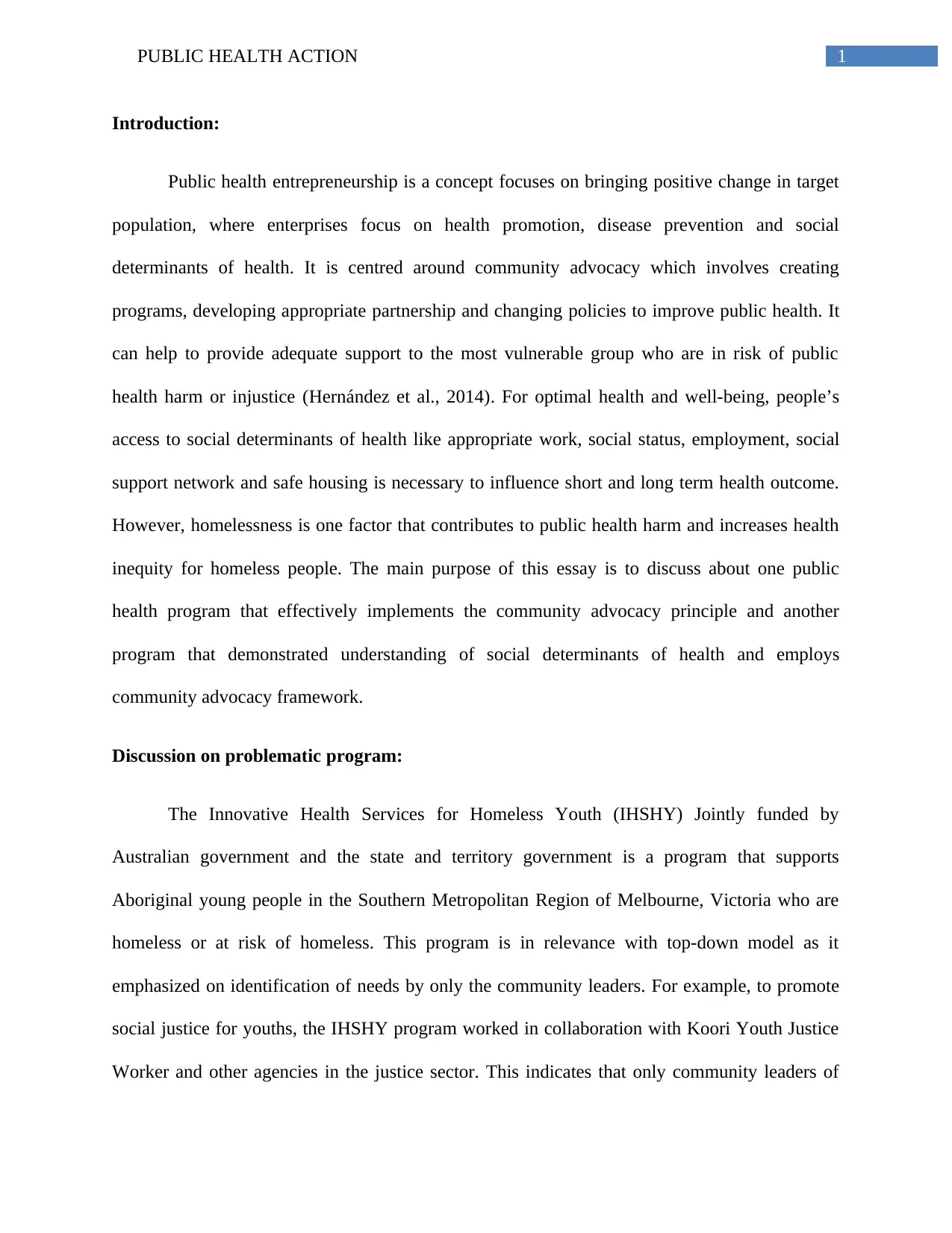
1PUBLIC HEALTH ACTION
Introduction:
Public health entrepreneurship is a concept focuses on bringing positive change in target
population, where enterprises focus on health promotion, disease prevention and social
determinants of health. It is centred around community advocacy which involves creating
programs, developing appropriate partnership and changing policies to improve public health. It
can help to provide adequate support to the most vulnerable group who are in risk of public
health harm or injustice (Hernández et al., 2014). For optimal health and well-being, people’s
access to social determinants of health like appropriate work, social status, employment, social
support network and safe housing is necessary to influence short and long term health outcome.
However, homelessness is one factor that contributes to public health harm and increases health
inequity for homeless people. The main purpose of this essay is to discuss about one public
health program that effectively implements the community advocacy principle and another
program that demonstrated understanding of social determinants of health and employs
community advocacy framework.
Discussion on problematic program:
The Innovative Health Services for Homeless Youth (IHSHY) Jointly funded by
Australian government and the state and territory government is a program that supports
Aboriginal young people in the Southern Metropolitan Region of Melbourne, Victoria who are
homeless or at risk of homeless. This program is in relevance with top-down model as it
emphasized on identification of needs by only the community leaders. For example, to promote
social justice for youths, the IHSHY program worked in collaboration with Koori Youth Justice
Worker and other agencies in the justice sector. This indicates that only community leaders of
Introduction:
Public health entrepreneurship is a concept focuses on bringing positive change in target
population, where enterprises focus on health promotion, disease prevention and social
determinants of health. It is centred around community advocacy which involves creating
programs, developing appropriate partnership and changing policies to improve public health. It
can help to provide adequate support to the most vulnerable group who are in risk of public
health harm or injustice (Hernández et al., 2014). For optimal health and well-being, people’s
access to social determinants of health like appropriate work, social status, employment, social
support network and safe housing is necessary to influence short and long term health outcome.
However, homelessness is one factor that contributes to public health harm and increases health
inequity for homeless people. The main purpose of this essay is to discuss about one public
health program that effectively implements the community advocacy principle and another
program that demonstrated understanding of social determinants of health and employs
community advocacy framework.
Discussion on problematic program:
The Innovative Health Services for Homeless Youth (IHSHY) Jointly funded by
Australian government and the state and territory government is a program that supports
Aboriginal young people in the Southern Metropolitan Region of Melbourne, Victoria who are
homeless or at risk of homeless. This program is in relevance with top-down model as it
emphasized on identification of needs by only the community leaders. For example, to promote
social justice for youths, the IHSHY program worked in collaboration with Koori Youth Justice
Worker and other agencies in the justice sector. This indicates that only community leaders of
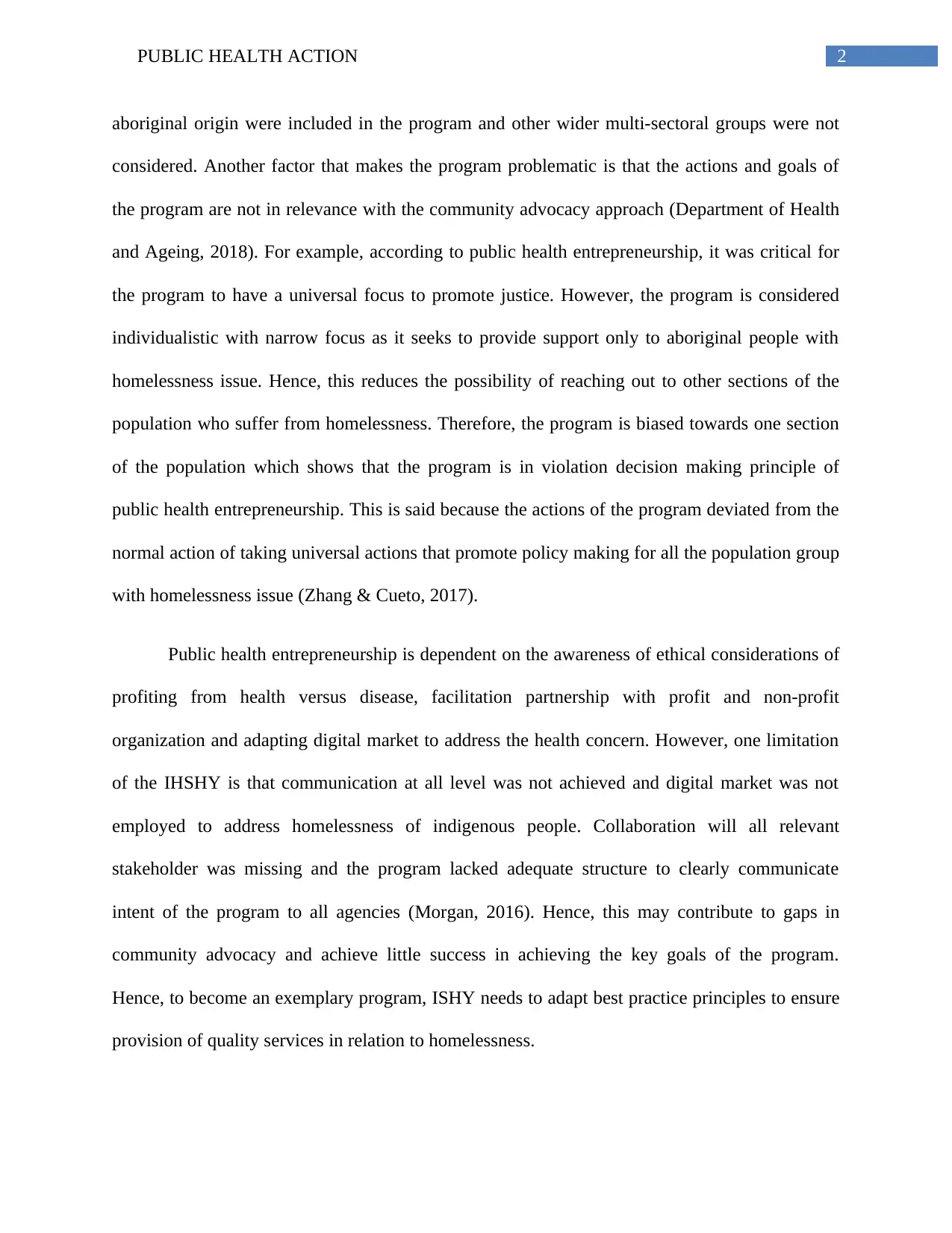
2PUBLIC HEALTH ACTION
aboriginal origin were included in the program and other wider multi-sectoral groups were not
considered. Another factor that makes the program problematic is that the actions and goals of
the program are not in relevance with the community advocacy approach (Department of Health
and Ageing, 2018). For example, according to public health entrepreneurship, it was critical for
the program to have a universal focus to promote justice. However, the program is considered
individualistic with narrow focus as it seeks to provide support only to aboriginal people with
homelessness issue. Hence, this reduces the possibility of reaching out to other sections of the
population who suffer from homelessness. Therefore, the program is biased towards one section
of the population which shows that the program is in violation decision making principle of
public health entrepreneurship. This is said because the actions of the program deviated from the
normal action of taking universal actions that promote policy making for all the population group
with homelessness issue (Zhang & Cueto, 2017).
Public health entrepreneurship is dependent on the awareness of ethical considerations of
profiting from health versus disease, facilitation partnership with profit and non-profit
organization and adapting digital market to address the health concern. However, one limitation
of the IHSHY is that communication at all level was not achieved and digital market was not
employed to address homelessness of indigenous people. Collaboration will all relevant
stakeholder was missing and the program lacked adequate structure to clearly communicate
intent of the program to all agencies (Morgan, 2016). Hence, this may contribute to gaps in
community advocacy and achieve little success in achieving the key goals of the program.
Hence, to become an exemplary program, ISHY needs to adapt best practice principles to ensure
provision of quality services in relation to homelessness.
aboriginal origin were included in the program and other wider multi-sectoral groups were not
considered. Another factor that makes the program problematic is that the actions and goals of
the program are not in relevance with the community advocacy approach (Department of Health
and Ageing, 2018). For example, according to public health entrepreneurship, it was critical for
the program to have a universal focus to promote justice. However, the program is considered
individualistic with narrow focus as it seeks to provide support only to aboriginal people with
homelessness issue. Hence, this reduces the possibility of reaching out to other sections of the
population who suffer from homelessness. Therefore, the program is biased towards one section
of the population which shows that the program is in violation decision making principle of
public health entrepreneurship. This is said because the actions of the program deviated from the
normal action of taking universal actions that promote policy making for all the population group
with homelessness issue (Zhang & Cueto, 2017).
Public health entrepreneurship is dependent on the awareness of ethical considerations of
profiting from health versus disease, facilitation partnership with profit and non-profit
organization and adapting digital market to address the health concern. However, one limitation
of the IHSHY is that communication at all level was not achieved and digital market was not
employed to address homelessness of indigenous people. Collaboration will all relevant
stakeholder was missing and the program lacked adequate structure to clearly communicate
intent of the program to all agencies (Morgan, 2016). Hence, this may contribute to gaps in
community advocacy and achieve little success in achieving the key goals of the program.
Hence, to become an exemplary program, ISHY needs to adapt best practice principles to ensure
provision of quality services in relation to homelessness.
⊘ This is a preview!⊘
Do you want full access?
Subscribe today to unlock all pages.

Trusted by 1+ million students worldwide
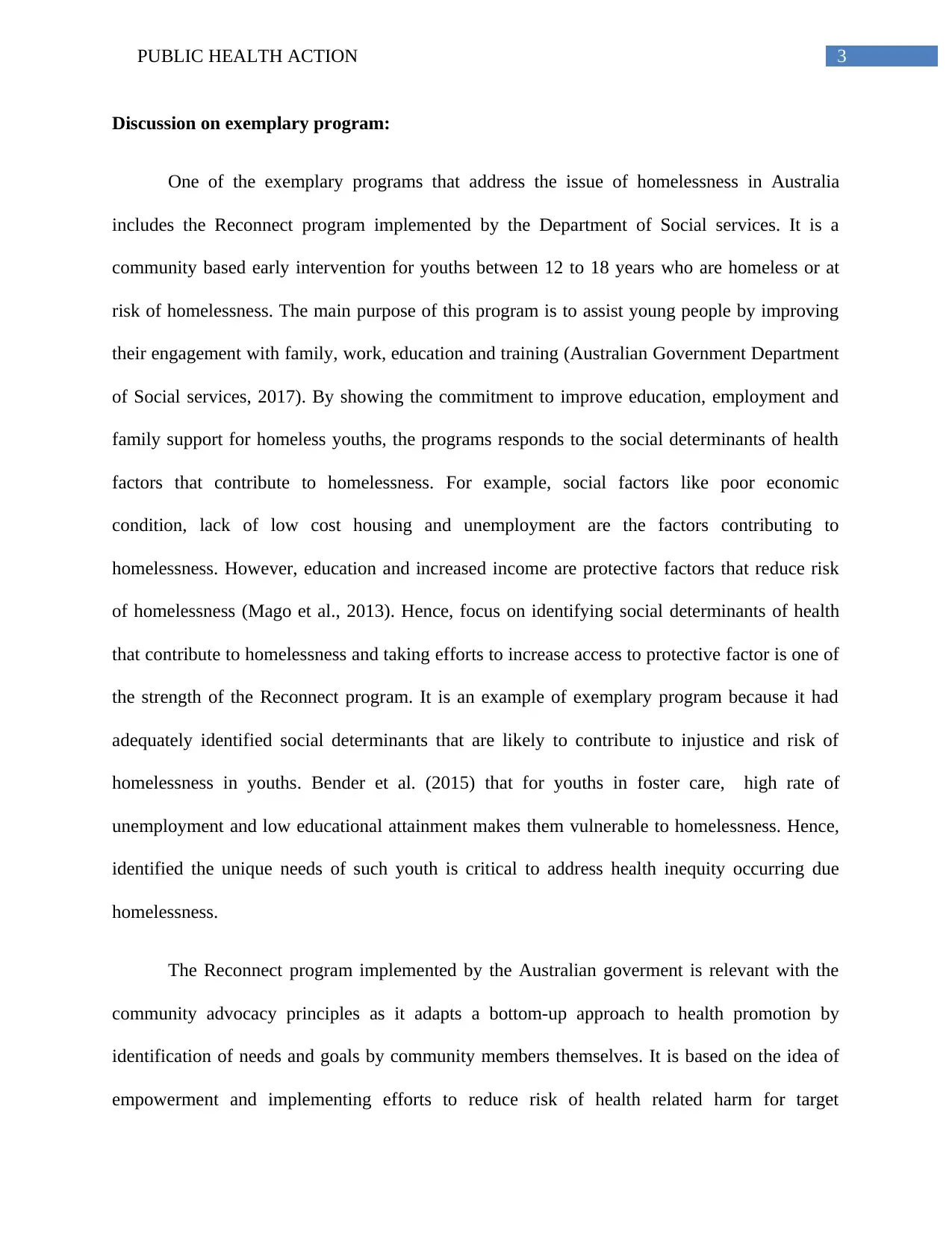
3PUBLIC HEALTH ACTION
Discussion on exemplary program:
One of the exemplary programs that address the issue of homelessness in Australia
includes the Reconnect program implemented by the Department of Social services. It is a
community based early intervention for youths between 12 to 18 years who are homeless or at
risk of homelessness. The main purpose of this program is to assist young people by improving
their engagement with family, work, education and training (Australian Government Department
of Social services, 2017). By showing the commitment to improve education, employment and
family support for homeless youths, the programs responds to the social determinants of health
factors that contribute to homelessness. For example, social factors like poor economic
condition, lack of low cost housing and unemployment are the factors contributing to
homelessness. However, education and increased income are protective factors that reduce risk
of homelessness (Mago et al., 2013). Hence, focus on identifying social determinants of health
that contribute to homelessness and taking efforts to increase access to protective factor is one of
the strength of the Reconnect program. It is an example of exemplary program because it had
adequately identified social determinants that are likely to contribute to injustice and risk of
homelessness in youths. Bender et al. (2015) that for youths in foster care, high rate of
unemployment and low educational attainment makes them vulnerable to homelessness. Hence,
identified the unique needs of such youth is critical to address health inequity occurring due
homelessness.
The Reconnect program implemented by the Australian goverment is relevant with the
community advocacy principles as it adapts a bottom-up approach to health promotion by
identification of needs and goals by community members themselves. It is based on the idea of
empowerment and implementing efforts to reduce risk of health related harm for target
Discussion on exemplary program:
One of the exemplary programs that address the issue of homelessness in Australia
includes the Reconnect program implemented by the Department of Social services. It is a
community based early intervention for youths between 12 to 18 years who are homeless or at
risk of homelessness. The main purpose of this program is to assist young people by improving
their engagement with family, work, education and training (Australian Government Department
of Social services, 2017). By showing the commitment to improve education, employment and
family support for homeless youths, the programs responds to the social determinants of health
factors that contribute to homelessness. For example, social factors like poor economic
condition, lack of low cost housing and unemployment are the factors contributing to
homelessness. However, education and increased income are protective factors that reduce risk
of homelessness (Mago et al., 2013). Hence, focus on identifying social determinants of health
that contribute to homelessness and taking efforts to increase access to protective factor is one of
the strength of the Reconnect program. It is an example of exemplary program because it had
adequately identified social determinants that are likely to contribute to injustice and risk of
homelessness in youths. Bender et al. (2015) that for youths in foster care, high rate of
unemployment and low educational attainment makes them vulnerable to homelessness. Hence,
identified the unique needs of such youth is critical to address health inequity occurring due
homelessness.
The Reconnect program implemented by the Australian goverment is relevant with the
community advocacy principles as it adapts a bottom-up approach to health promotion by
identification of needs and goals by community members themselves. It is based on the idea of
empowerment and implementing efforts to reduce risk of health related harm for target
Paraphrase This Document
Need a fresh take? Get an instant paraphrase of this document with our AI Paraphraser
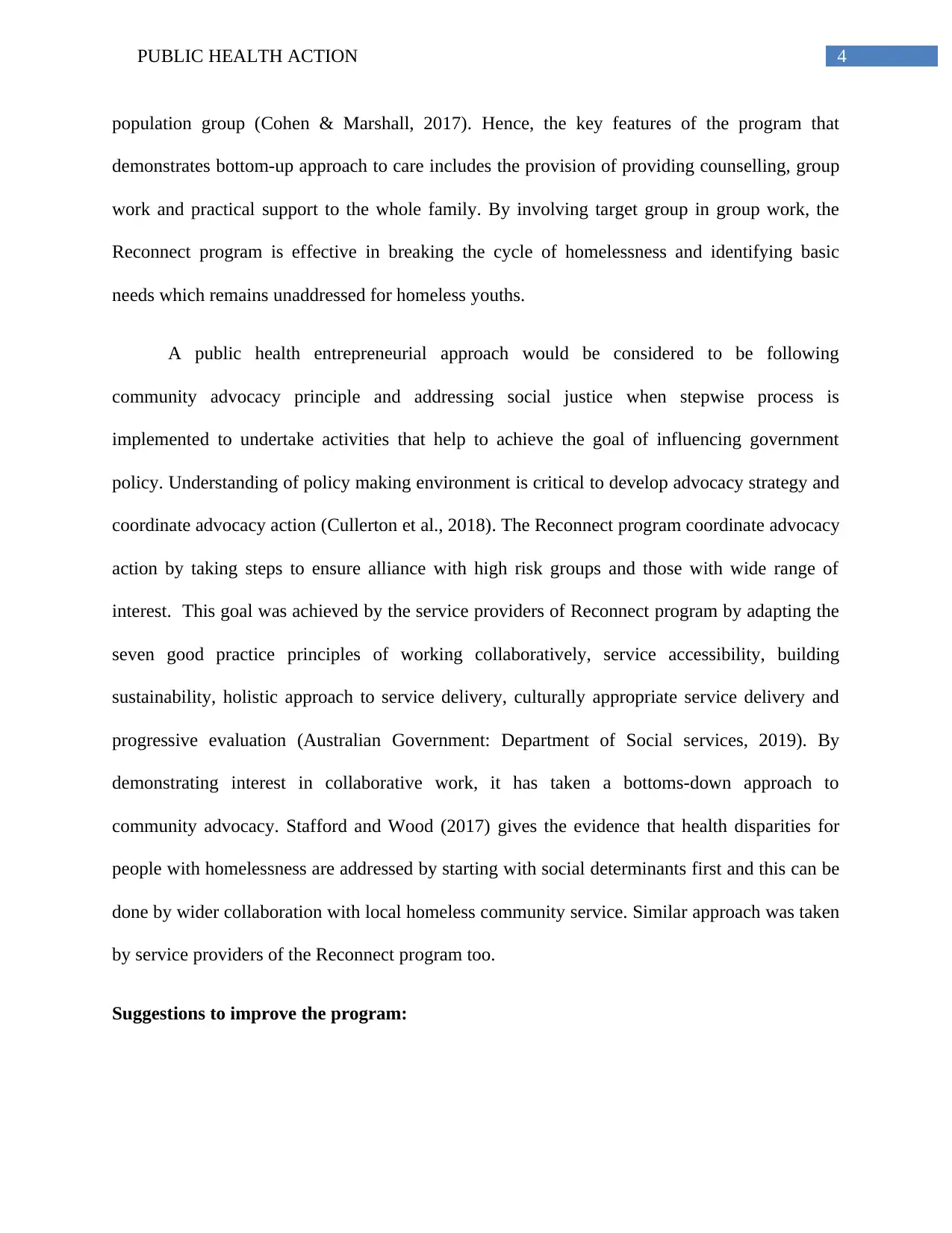
4PUBLIC HEALTH ACTION
population group (Cohen & Marshall, 2017). Hence, the key features of the program that
demonstrates bottom-up approach to care includes the provision of providing counselling, group
work and practical support to the whole family. By involving target group in group work, the
Reconnect program is effective in breaking the cycle of homelessness and identifying basic
needs which remains unaddressed for homeless youths.
A public health entrepreneurial approach would be considered to be following
community advocacy principle and addressing social justice when stepwise process is
implemented to undertake activities that help to achieve the goal of influencing government
policy. Understanding of policy making environment is critical to develop advocacy strategy and
coordinate advocacy action (Cullerton et al., 2018). The Reconnect program coordinate advocacy
action by taking steps to ensure alliance with high risk groups and those with wide range of
interest. This goal was achieved by the service providers of Reconnect program by adapting the
seven good practice principles of working collaboratively, service accessibility, building
sustainability, holistic approach to service delivery, culturally appropriate service delivery and
progressive evaluation (Australian Government: Department of Social services, 2019). By
demonstrating interest in collaborative work, it has taken a bottoms-down approach to
community advocacy. Stafford and Wood (2017) gives the evidence that health disparities for
people with homelessness are addressed by starting with social determinants first and this can be
done by wider collaboration with local homeless community service. Similar approach was taken
by service providers of the Reconnect program too.
Suggestions to improve the program:
population group (Cohen & Marshall, 2017). Hence, the key features of the program that
demonstrates bottom-up approach to care includes the provision of providing counselling, group
work and practical support to the whole family. By involving target group in group work, the
Reconnect program is effective in breaking the cycle of homelessness and identifying basic
needs which remains unaddressed for homeless youths.
A public health entrepreneurial approach would be considered to be following
community advocacy principle and addressing social justice when stepwise process is
implemented to undertake activities that help to achieve the goal of influencing government
policy. Understanding of policy making environment is critical to develop advocacy strategy and
coordinate advocacy action (Cullerton et al., 2018). The Reconnect program coordinate advocacy
action by taking steps to ensure alliance with high risk groups and those with wide range of
interest. This goal was achieved by the service providers of Reconnect program by adapting the
seven good practice principles of working collaboratively, service accessibility, building
sustainability, holistic approach to service delivery, culturally appropriate service delivery and
progressive evaluation (Australian Government: Department of Social services, 2019). By
demonstrating interest in collaborative work, it has taken a bottoms-down approach to
community advocacy. Stafford and Wood (2017) gives the evidence that health disparities for
people with homelessness are addressed by starting with social determinants first and this can be
done by wider collaboration with local homeless community service. Similar approach was taken
by service providers of the Reconnect program too.
Suggestions to improve the program:
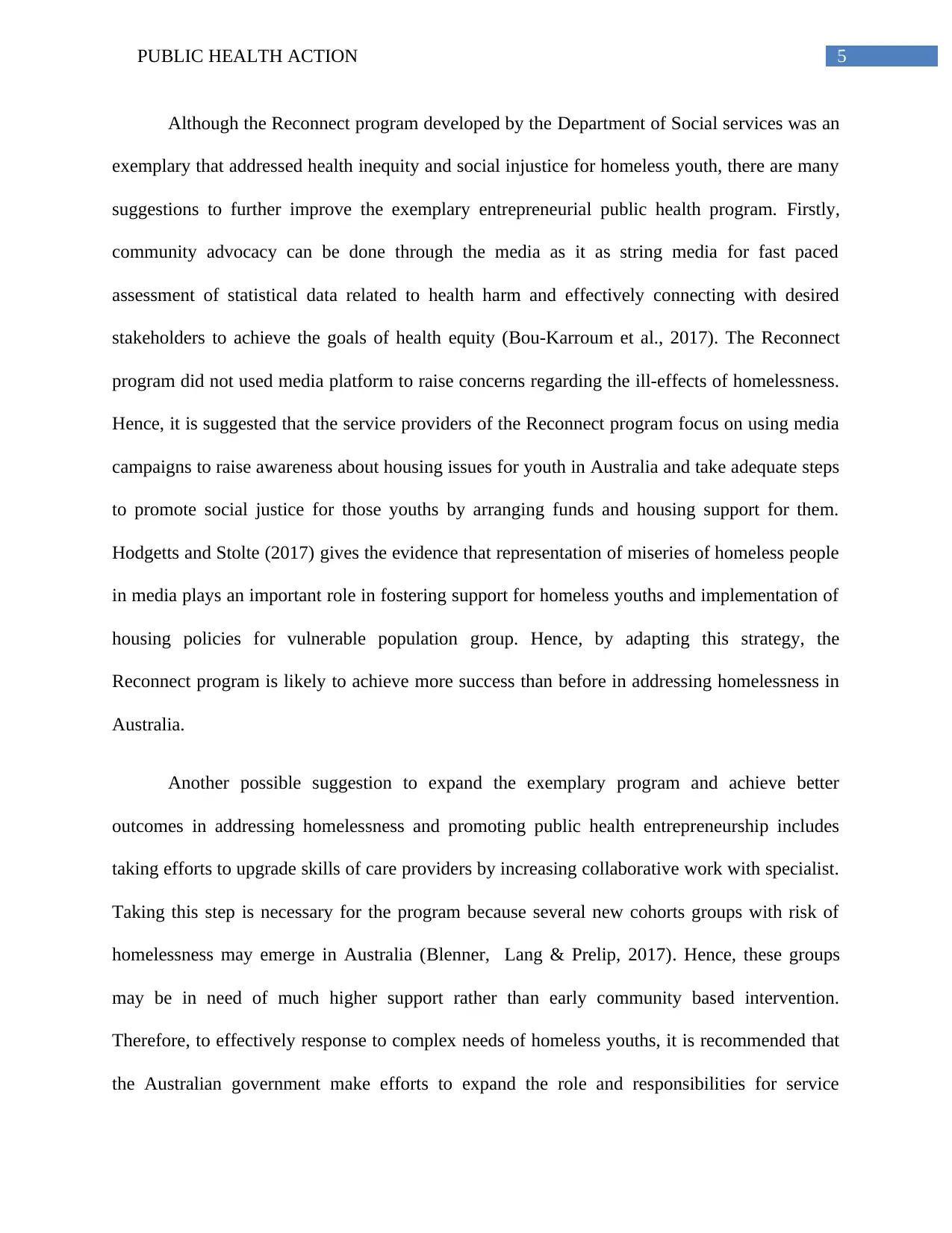
5PUBLIC HEALTH ACTION
Although the Reconnect program developed by the Department of Social services was an
exemplary that addressed health inequity and social injustice for homeless youth, there are many
suggestions to further improve the exemplary entrepreneurial public health program. Firstly,
community advocacy can be done through the media as it as string media for fast paced
assessment of statistical data related to health harm and effectively connecting with desired
stakeholders to achieve the goals of health equity (Bou-Karroum et al., 2017). The Reconnect
program did not used media platform to raise concerns regarding the ill-effects of homelessness.
Hence, it is suggested that the service providers of the Reconnect program focus on using media
campaigns to raise awareness about housing issues for youth in Australia and take adequate steps
to promote social justice for those youths by arranging funds and housing support for them.
Hodgetts and Stolte (2017) gives the evidence that representation of miseries of homeless people
in media plays an important role in fostering support for homeless youths and implementation of
housing policies for vulnerable population group. Hence, by adapting this strategy, the
Reconnect program is likely to achieve more success than before in addressing homelessness in
Australia.
Another possible suggestion to expand the exemplary program and achieve better
outcomes in addressing homelessness and promoting public health entrepreneurship includes
taking efforts to upgrade skills of care providers by increasing collaborative work with specialist.
Taking this step is necessary for the program because several new cohorts groups with risk of
homelessness may emerge in Australia (Blenner, Lang & Prelip, 2017). Hence, these groups
may be in need of much higher support rather than early community based intervention.
Therefore, to effectively response to complex needs of homeless youths, it is recommended that
the Australian government make efforts to expand the role and responsibilities for service
Although the Reconnect program developed by the Department of Social services was an
exemplary that addressed health inequity and social injustice for homeless youth, there are many
suggestions to further improve the exemplary entrepreneurial public health program. Firstly,
community advocacy can be done through the media as it as string media for fast paced
assessment of statistical data related to health harm and effectively connecting with desired
stakeholders to achieve the goals of health equity (Bou-Karroum et al., 2017). The Reconnect
program did not used media platform to raise concerns regarding the ill-effects of homelessness.
Hence, it is suggested that the service providers of the Reconnect program focus on using media
campaigns to raise awareness about housing issues for youth in Australia and take adequate steps
to promote social justice for those youths by arranging funds and housing support for them.
Hodgetts and Stolte (2017) gives the evidence that representation of miseries of homeless people
in media plays an important role in fostering support for homeless youths and implementation of
housing policies for vulnerable population group. Hence, by adapting this strategy, the
Reconnect program is likely to achieve more success than before in addressing homelessness in
Australia.
Another possible suggestion to expand the exemplary program and achieve better
outcomes in addressing homelessness and promoting public health entrepreneurship includes
taking efforts to upgrade skills of care providers by increasing collaborative work with specialist.
Taking this step is necessary for the program because several new cohorts groups with risk of
homelessness may emerge in Australia (Blenner, Lang & Prelip, 2017). Hence, these groups
may be in need of much higher support rather than early community based intervention.
Therefore, to effectively response to complex needs of homeless youths, it is recommended that
the Australian government make efforts to expand the role and responsibilities for service
⊘ This is a preview!⊘
Do you want full access?
Subscribe today to unlock all pages.

Trusted by 1+ million students worldwide
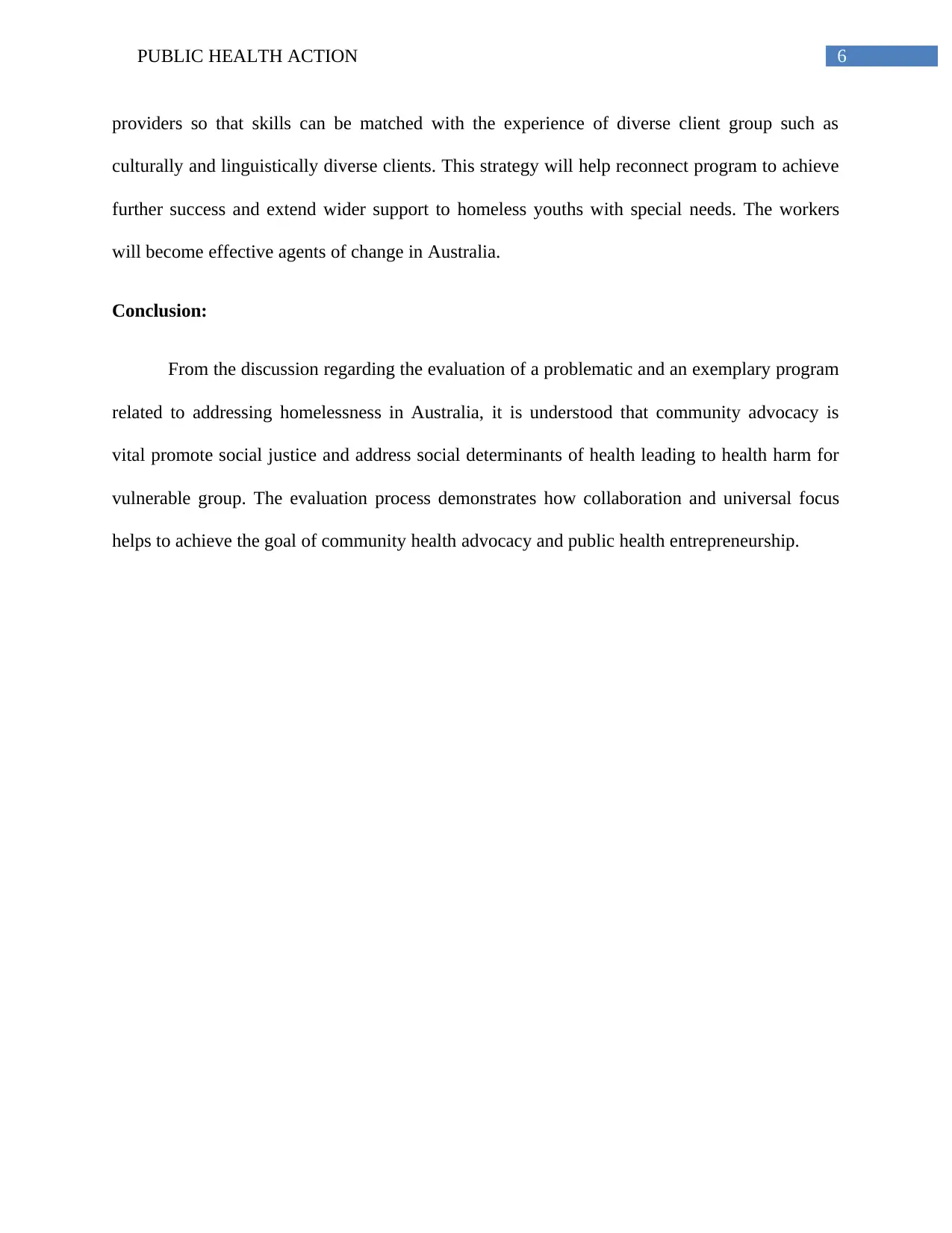
6PUBLIC HEALTH ACTION
providers so that skills can be matched with the experience of diverse client group such as
culturally and linguistically diverse clients. This strategy will help reconnect program to achieve
further success and extend wider support to homeless youths with special needs. The workers
will become effective agents of change in Australia.
Conclusion:
From the discussion regarding the evaluation of a problematic and an exemplary program
related to addressing homelessness in Australia, it is understood that community advocacy is
vital promote social justice and address social determinants of health leading to health harm for
vulnerable group. The evaluation process demonstrates how collaboration and universal focus
helps to achieve the goal of community health advocacy and public health entrepreneurship.
providers so that skills can be matched with the experience of diverse client group such as
culturally and linguistically diverse clients. This strategy will help reconnect program to achieve
further success and extend wider support to homeless youths with special needs. The workers
will become effective agents of change in Australia.
Conclusion:
From the discussion regarding the evaluation of a problematic and an exemplary program
related to addressing homelessness in Australia, it is understood that community advocacy is
vital promote social justice and address social determinants of health leading to health harm for
vulnerable group. The evaluation process demonstrates how collaboration and universal focus
helps to achieve the goal of community health advocacy and public health entrepreneurship.
Paraphrase This Document
Need a fresh take? Get an instant paraphrase of this document with our AI Paraphraser
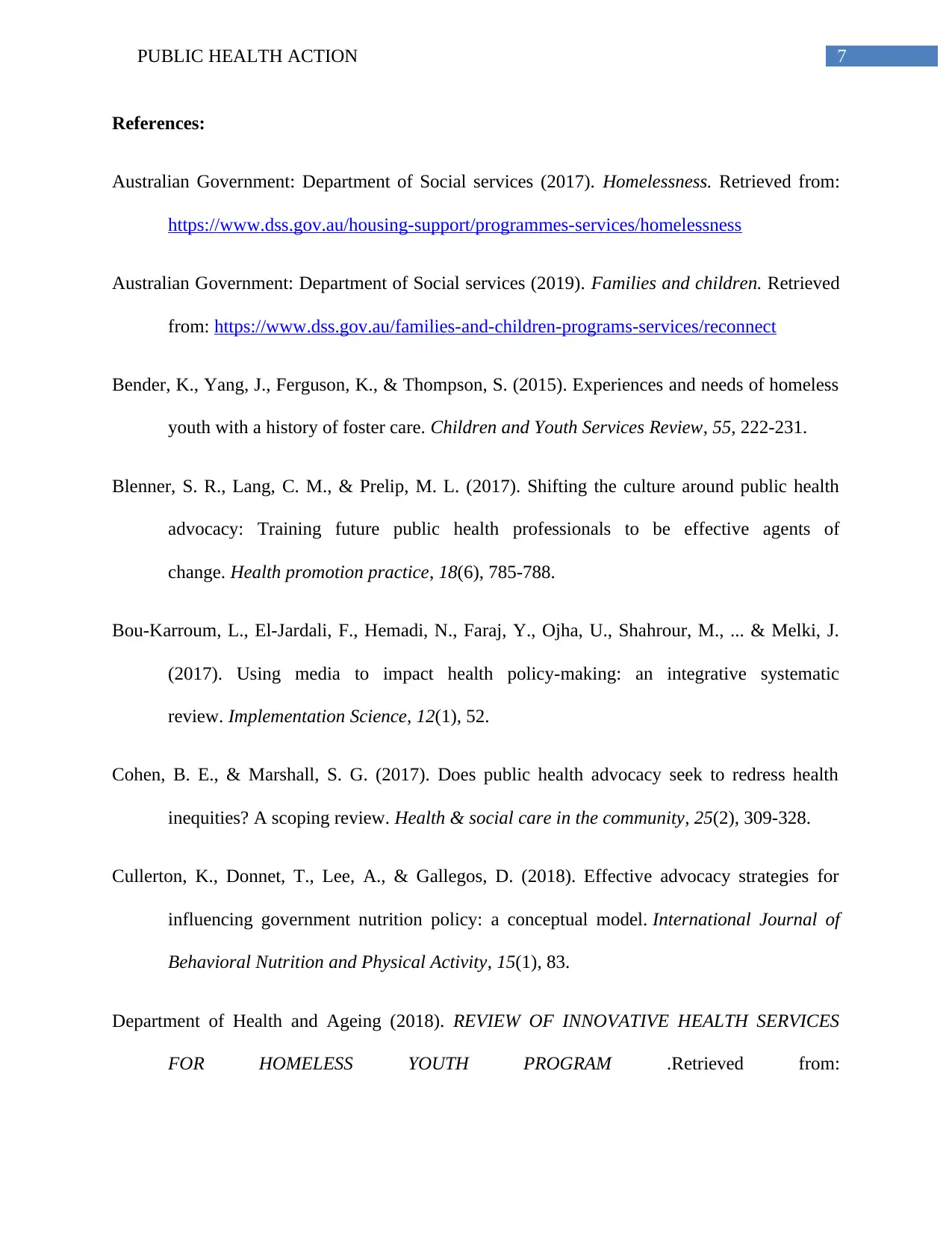
7PUBLIC HEALTH ACTION
References:
Australian Government: Department of Social services (2017). Homelessness. Retrieved from:
https://www.dss.gov.au/housing-support/programmes-services/homelessness
Australian Government: Department of Social services (2019). Families and children. Retrieved
from: https://www.dss.gov.au/families-and-children-programs-services/reconnect
Bender, K., Yang, J., Ferguson, K., & Thompson, S. (2015). Experiences and needs of homeless
youth with a history of foster care. Children and Youth Services Review, 55, 222-231.
Blenner, S. R., Lang, C. M., & Prelip, M. L. (2017). Shifting the culture around public health
advocacy: Training future public health professionals to be effective agents of
change. Health promotion practice, 18(6), 785-788.
Bou-Karroum, L., El-Jardali, F., Hemadi, N., Faraj, Y., Ojha, U., Shahrour, M., ... & Melki, J.
(2017). Using media to impact health policy-making: an integrative systematic
review. Implementation Science, 12(1), 52.
Cohen, B. E., & Marshall, S. G. (2017). Does public health advocacy seek to redress health
inequities? A scoping review. Health & social care in the community, 25(2), 309-328.
Cullerton, K., Donnet, T., Lee, A., & Gallegos, D. (2018). Effective advocacy strategies for
influencing government nutrition policy: a conceptual model. International Journal of
Behavioral Nutrition and Physical Activity, 15(1), 83.
Department of Health and Ageing (2018). REVIEW OF INNOVATIVE HEALTH SERVICES
FOR HOMELESS YOUTH PROGRAM .Retrieved from:
References:
Australian Government: Department of Social services (2017). Homelessness. Retrieved from:
https://www.dss.gov.au/housing-support/programmes-services/homelessness
Australian Government: Department of Social services (2019). Families and children. Retrieved
from: https://www.dss.gov.au/families-and-children-programs-services/reconnect
Bender, K., Yang, J., Ferguson, K., & Thompson, S. (2015). Experiences and needs of homeless
youth with a history of foster care. Children and Youth Services Review, 55, 222-231.
Blenner, S. R., Lang, C. M., & Prelip, M. L. (2017). Shifting the culture around public health
advocacy: Training future public health professionals to be effective agents of
change. Health promotion practice, 18(6), 785-788.
Bou-Karroum, L., El-Jardali, F., Hemadi, N., Faraj, Y., Ojha, U., Shahrour, M., ... & Melki, J.
(2017). Using media to impact health policy-making: an integrative systematic
review. Implementation Science, 12(1), 52.
Cohen, B. E., & Marshall, S. G. (2017). Does public health advocacy seek to redress health
inequities? A scoping review. Health & social care in the community, 25(2), 309-328.
Cullerton, K., Donnet, T., Lee, A., & Gallegos, D. (2018). Effective advocacy strategies for
influencing government nutrition policy: a conceptual model. International Journal of
Behavioral Nutrition and Physical Activity, 15(1), 83.
Department of Health and Ageing (2018). REVIEW OF INNOVATIVE HEALTH SERVICES
FOR HOMELESS YOUTH PROGRAM .Retrieved from:
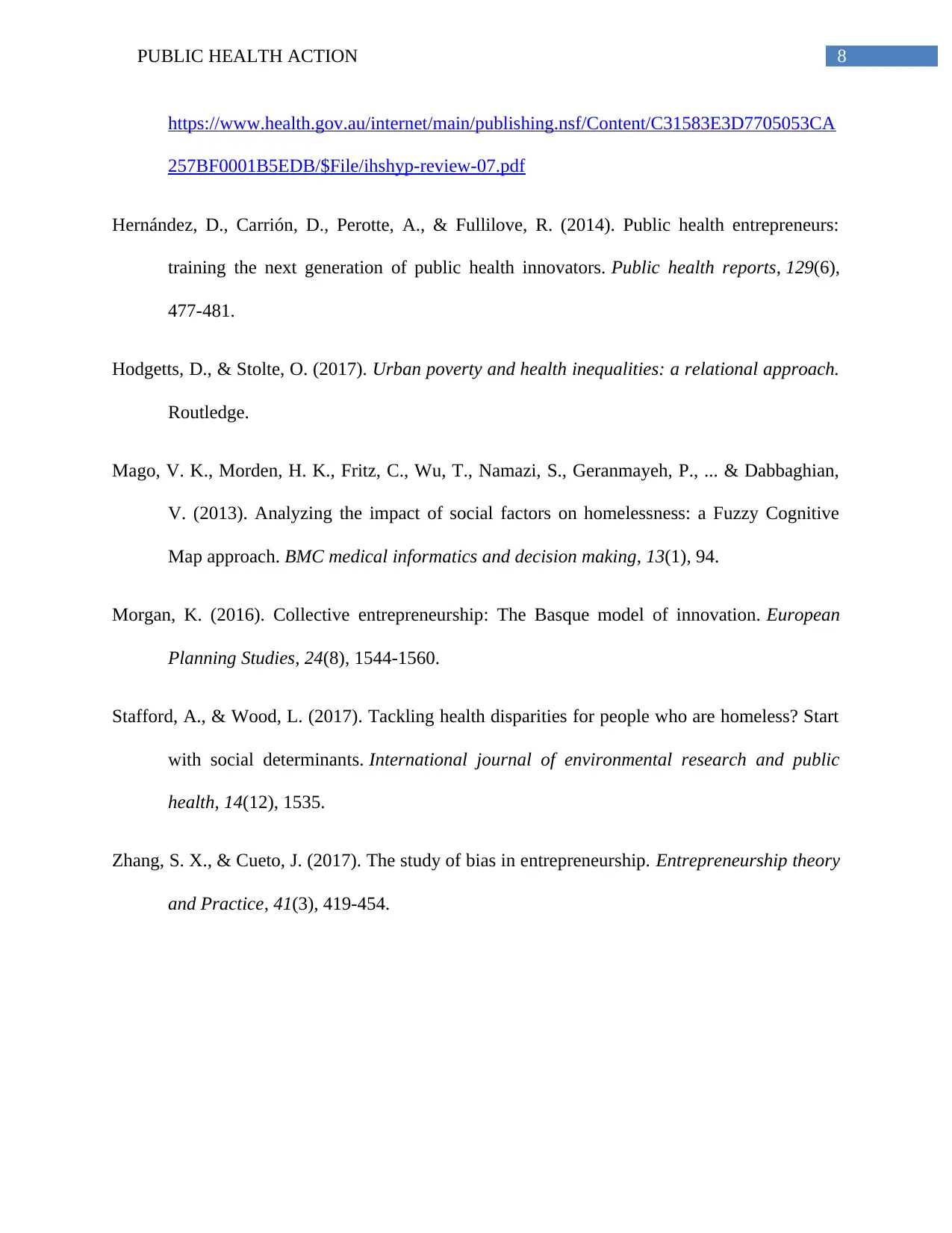
8PUBLIC HEALTH ACTION
https://www.health.gov.au/internet/main/publishing.nsf/Content/C31583E3D7705053CA
257BF0001B5EDB/$File/ihshyp-review-07.pdf
Hernández, D., Carrión, D., Perotte, A., & Fullilove, R. (2014). Public health entrepreneurs:
training the next generation of public health innovators. Public health reports, 129(6),
477-481.
Hodgetts, D., & Stolte, O. (2017). Urban poverty and health inequalities: a relational approach.
Routledge.
Mago, V. K., Morden, H. K., Fritz, C., Wu, T., Namazi, S., Geranmayeh, P., ... & Dabbaghian,
V. (2013). Analyzing the impact of social factors on homelessness: a Fuzzy Cognitive
Map approach. BMC medical informatics and decision making, 13(1), 94.
Morgan, K. (2016). Collective entrepreneurship: The Basque model of innovation. European
Planning Studies, 24(8), 1544-1560.
Stafford, A., & Wood, L. (2017). Tackling health disparities for people who are homeless? Start
with social determinants. International journal of environmental research and public
health, 14(12), 1535.
Zhang, S. X., & Cueto, J. (2017). The study of bias in entrepreneurship. Entrepreneurship theory
and Practice, 41(3), 419-454.
https://www.health.gov.au/internet/main/publishing.nsf/Content/C31583E3D7705053CA
257BF0001B5EDB/$File/ihshyp-review-07.pdf
Hernández, D., Carrión, D., Perotte, A., & Fullilove, R. (2014). Public health entrepreneurs:
training the next generation of public health innovators. Public health reports, 129(6),
477-481.
Hodgetts, D., & Stolte, O. (2017). Urban poverty and health inequalities: a relational approach.
Routledge.
Mago, V. K., Morden, H. K., Fritz, C., Wu, T., Namazi, S., Geranmayeh, P., ... & Dabbaghian,
V. (2013). Analyzing the impact of social factors on homelessness: a Fuzzy Cognitive
Map approach. BMC medical informatics and decision making, 13(1), 94.
Morgan, K. (2016). Collective entrepreneurship: The Basque model of innovation. European
Planning Studies, 24(8), 1544-1560.
Stafford, A., & Wood, L. (2017). Tackling health disparities for people who are homeless? Start
with social determinants. International journal of environmental research and public
health, 14(12), 1535.
Zhang, S. X., & Cueto, J. (2017). The study of bias in entrepreneurship. Entrepreneurship theory
and Practice, 41(3), 419-454.
⊘ This is a preview!⊘
Do you want full access?
Subscribe today to unlock all pages.

Trusted by 1+ million students worldwide
1 out of 9
Related Documents
Your All-in-One AI-Powered Toolkit for Academic Success.
+13062052269
info@desklib.com
Available 24*7 on WhatsApp / Email
![[object Object]](/_next/static/media/star-bottom.7253800d.svg)
Unlock your academic potential
Copyright © 2020–2025 A2Z Services. All Rights Reserved. Developed and managed by ZUCOL.





